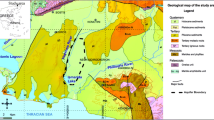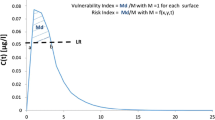Abstract
The implementation of sanitary protection zones is one of the most widely used approaches for preventive groundwater protection. Current regulations are usually based on the determination of the horizontal groundwater travel time component, while the vertical component is commonly neglected. Karst aquifers are especially sensitive to contamination through the unsaturated zone, and consequently numerous methods for determining intrinsic vulnerability have been developed. Many of these methods take into account the effects in the unsaturated zone, but mostly by indirect means. Vulnerability assessment methods do not fully reflect the component of groundwater residence time, making groundwater delineation zoning more difficult, with possible ambiguous and subjective results. Therefore, a method that incorporates the two equally important components (horizontal and vertical) is needed to facilitate groundwater protection zoning. The time-dependent model represents a redesigned vulnerability assessment method, created for karst aquifers, to incorporate the travel time component. This model incudes horizontal and vertical groundwater flow components and also considers a surface component toward ponor zones. The baseline for groundwater travel time through the unsaturated zone was adopted from the Time–input method. The estimation of the horizontal travel time component was based on the conceptual duality of flow in karst aquifers, which has fast and slow components. For the allogenic part of the karst aquifer catchment area (subcatchments of the ponor zone) travel time components were estimated according to different influencing factors e.g. slope, soil type, vegetation, and rainfall intensity. This methodology was tested on the case example of the Crnica karst source located at the western part of the Kučaj anticline in Eastern Serbia. The methodology was shown to be more accurate and appropriate for the delineation of the groundwater protection zones than existing approaches.











Similar content being viewed by others
References
Andreo B, Ravbar N, Vías JM (2008) Source vulnerability mapping in carbonate (karst) aquifers by extension of the COP method: application to pilot sites. Hydrogeol J 17(3):749–758. doi:10.1007/s10040-008-0391-1
Atkinson TC (1977) Diffuse flow and conduit flow in limestone terrain in the Mendip Hills. Somerset (Great Britain). J Hydrol 35:93–103
Bakalowicz M (2005) Karst groundwater: a challenge for new resources. Hydrogeol J 13(1):148–160. doi:10.1007/s10040-008-0283-4
Benischke R, Goldscheider N, Smart C (2007) Tracer techniques. In: Goldscheider N, Drew D (eds) Methods in karst hydrogeology, international contribution to hydrogeology, IAH, vol 26. Taylor & Francis/Balkema, London, pp 147–170
Bonacci O (1993) Karst springs hydrographs as indicators of karst aquifers. J Hydrol 38:51–62
Chave P, Howard G, Schijven J, Appleyard S, Fladerer F, Schimon W (2006) Groundwater protection zones. In: Schmoll O, Howard G, Chilton J, Chorus I (eds) Protecting groundwater for health, managing the quality of drinking-water sources. IWA Publishing, London, pp 465–492
Civita M (2008) An improved method for delineating source protection zones for karst springs based on analysis of recession curve data. Hydrogeol J 16:855–869. doi:10.1007/s10040-008-0283-4
ConnDot (2000) Connecticut Department of Transportation Drainage manual. ConnDot, Newington
Conservation Engineering Division (1986) Urban hydrology for small watersheds, National Resources Conservation Service, U.S. Dep. Agric., Tech. Rel. No. 55
Cvijić J (1893) Geographical Studies in the Area of Kučaj in Eastern Serbia. Geološki anali Balkanskog poluostrva Annales géologiques de la Peninsule balkanique 5(1):7–172 (in Serbian)
Doerfliger N, Zwahlen F (1997) EPIK: a new method for outlining of protection areas in karstic environment. In: Günay G, Jonshon AI (eds) International symposium and field seminar on “Karst waters and environmental impacts”. Antalya, Turkey. Balkema, Rotterdam, pp 117–123
Engman ET (1986) Roughness coefficients for routing surface runoff. J Irrig Drain Eng-Asce 112(1):39–53
ESRI (2014) ArcGIS Desktop: Release 10.2. Redlands, CA: Environmental Systems Research Institute
European Commission (2007) Common Implementation Strategy for the Water Framework Directive (2000/60/EC). Guidance Document No. 16. Guidance on Groundwater in Drinking Water Protected Areas. European Community, Luxembourg
Ford DC, Williams P (2007) Karst hydrogeology and geomorphology. Wiley, Chichester
Foster S, Hirata R, Gomes D, D’Elia M, Paris M (2002) Groundwater quality protection. A guide for water utilities, municipal authorities, and environment agencies. The World Bank, Washington
Goldscheider N, Klute M, Sturm S, Hötzl H (2000) The PI method—a GIS-based approach to mapping groundwater vulnerability with special consideration of karst aquifers. Z Angew Geol 46(3):157–166
Hölting B, Haertlé T, Hohberger KH, Nachtigall KH, Villinger E, Weinzierl W, Wrobel JP (1995) Konzept zur Ermittlung der Schutzfunktion der Grundwasserüber-deckung. Geol Jahrb C63:5–24
Jemcov I, Petric M (2009) Measured precipitation versus effective infiltration and their influence on the assessment of karst systems based on results of the time series analysis. J Hydrol 379:304–314. doi:10.1016/j.jhydrol.2009.10.016
Jemcov I, Pavlović R, Stevanović Z (2002) Morphotectonic analysis in hydrogeological research of karst terrains—A case-study of SW Kucaj Massif, Eastern Serbia. Theor Appl Karstol 15:51–59
Kavouri K, Plagnes V, Tremoulet J, Dörfliger N, Reijiba F, Marchet P (2011) PaPRIKA: a method for estimating karst resource and source vulnerability—application to the Ouysse karst system (southwest France). Hydrogeol J 19(2):339–353. doi:10.1007/s10040-010-0688-8
Kralik M, Keimel T (2003) Time-input, an innovative groundwater-vulnerability assessment scheme: application to an alpine test site. Environ Geol 44(6):679–686. doi:10.1007/s00254-003-0809-y
Larocque M, Mangin A, Razack M, Banton O (1998) Contribution of correlation and spectral analyses to the regional study of a large karst aquifer (Charente, France). J Hydrol 205:217–231. doi:10.1016/S0022-1694(97)00155-8
Mangin A (1994) Karst hydrogeology. In: Gilbert J, Danielopol DL, Stanford JA (eds) Groundwater ecology. Academic Press, San Diego, pp 43–67
Marsaud B (1996) Structure et fonctionnment de la zone noyée des karst à partir des résultats expérimentaux. Dissertation, Université Paris XI
Milanović P (2000) Geological engineering in karst, Dams, reservoirs, grouting, groundwater protection, water tapping, tunneling. Zebra Publishing Ltd, Belgrade
Mladenović A, Trivić B, Antić M, Cvetković V, Pavlović R, Radovanović S, Fügenschuh B (2014) The recent fault kinematics in the westernmost part of the Getic nappe system (Eastern Serbia): evidence from fault slip and focal mechanism data. Geol Carpath 65(2):147–161
Oehlmann S, Geyer T, Licha T, Sauter M (2015) Reducing the ambiguity of karst aquifer models by pattern matching of flow and transport on catchment scale. Hydrol Earth Syst Sci 19:3–912
Padilla A, Pulido-Bosch A (1995) Study hydrographs of karstic aquifers by means of correlation and cross-spectral analysis. J Hydrol 168:73–89
Paloc H (1985) Problemes de protection de la qualite des eaux souterraines en terrains calcaires. In: Matthess G, Foster SSD, Skinner AC (eds) Theoretical background, hydrogeology and practice of groundwater protection zones. International contributions to hydrogeology, IAH, vol 6. Verlag Heinz Heise, Hannover, pp 145–158
Pochon A, Tripet JP, Kozel R, Meylan B, Sinreich M, Zwahlen F (2008) Groundwater protection in fractured media: a vulnerability-based approach for delineating protection zones in Switzerland. Hydrogeol J 16:1267–1281. doi:10.1007/s10040-008-0323-0
Pronk M, Goldscheider N, Zopfi J, Zwahlen F (2009) Percolation and particle transport in the unsaturated zone of a karst aquifer. Groundwater 47(3):361–369. doi:10.1111/j.1745-6584.2008.00509.x
Ravbar N, Goldscheider N (2007) Proposed methodology of vulnerability and contamination risk mapping for the protection of karst aquifers in Slovenia. Acta Carsologica 36(3):397–411
Shaap MG, Liej FJ, van Genuchten M (1999) A bootstrap-neural network approach to predict soil hydraulic parameters. In: van Genuchten M, Liej FJ, Wu L (eds) Characterization and measurements of the hydraulic properties of unsaturated porous media. University of California at Riverside, Riverside, pp 1237–1250
Stevanović Z (1991) Hydrogeology of Carpathian-Balkan karst of eastern Serbia and water supply. Faculty of Mining and Geology, Belgrade
Stevanović Z, Dragišić V (1992) Directions of circulation of karst ground waters in the Carpatho-Balkanides, Serbia. In: Hötzl H, Werne A (eds) Tracer Hydrology. Balkema, Rotterdam, pp 291–295
Teutsch G, Sauter M (1991) Groundwater modelling in karst terrains: Scale effects, data acquisition and field validation. In: Quinlan J (ed) Proceedings of the third conference on hydrogeology, ecology, monitoring, and management of groundwater in karst. Nashville, pp 17–34
Vakanjac VR, Prohaska P, Polomčić D, Blagojević B, Vakanjac B (2013) Karst aquifer average catchment area assessment through monthly water balance equation with limited meteorological data set: application to Grza spring in Eastern Serbia. Acta Carsologica 42(1):109–119
Van Stempvoort D, Ewert L, Wassenaar L (1992) Aquifer vulnerability index: a GIS-compatible method for groundwater vulnerability mapping. Can Water Resour J 18:25–37
Van Waegeningh HG (1985) Overview of protection of groundwater quality. In: Matthess G, Foster SSD, Skinner AC (eds) Theoretical background, hydrogeology and practice of groundwater protection zones. International contributions to hydrogeology, IAH, vol 6. Verlag Heinz Heise, Hannover, pp 159–166
Worthington SRH (2007) Groundwater residence times in unconfined carbonate aquifers. J Cave Karst Stud 69(1):94–102
Živanović V (2015) Delineation of karst groundwater protection zones. In: Stevanovic Z (ed) Karst aquifers—characterization and engineering, professional practice in earth sciences. Springer, Switzerland. ISBN 978-3-319-12850-4. doi:10.1007/978-3-319-12850-4_17
Zwahlen F (ed) (2004) Vulnerability and risk mapping for the protection of carbonate (karstic) aquifers. Final report COST action 620. European Commission, Directorate-General for Research, Brüssel, Luxemburg
Acknowledgments
This research was supported by the Ministry of Education, Science and Technological Development (as a part of the Projects Nos. 43004 and 176022).
Author information
Authors and Affiliations
Corresponding author
Rights and permissions
About this article
Cite this article
Živanović, V., Jemcov, I., Dragišić, V. et al. Karst groundwater source protection based on the time-dependent vulnerability assessment model: Crnica springs case study, Eastern Serbia. Environ Earth Sci 75, 1224 (2016). https://doi.org/10.1007/s12665-016-6018-2
Received:
Accepted:
Published:
DOI: https://doi.org/10.1007/s12665-016-6018-2




